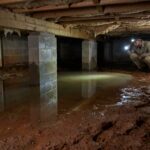Essential Guide to Foundation Repair: Preventing Structural Damage and Ensuring Home Stability
When you think of your home, you might picture cozy evenings by the fire, family gatherings around the dining table, or the occasional dance party in the living room. What you probably don’t envision is your house deciding to do the limbo because it’s lost its footing. While it sounds amusing, foundation issues are a serious matter that can lead to major structural damage if not addressed promptly. In this essential guide to foundation repair, we’ll explore how to prevent structural damage and ensure your home remains as stable as a well-placed coffee cup on a flat surface.
Understanding Your Foundation
First things first—what exactly is a foundation? Think of it as the broad, unsung hero of your home. It supports everything above it: the walls, the roof, and all the lovely memories made within. Foundations come in various types, including:
1. **Basement Foundations**: Where you can store everything from old board games to holiday decorations, and perhaps a few skeletons from past relationships (metaphorically speaking, of course).
2. **Crawl Space Foundations**: Great for ventilation and a little extra storage—just make sure you don’t invite the spiders to your next party.
3. **Slab Foundations**: These are a solid, single layer of concrete, perfect for homes in warmer climates, where the idea of a basement seems as appealing as penguins at a beach party.
Each foundation type has its own potential issues, and understanding these is the first step toward prevention.
Common Foundation Problems
Cracks and shifts in your foundation can lead to a host of headaches—some minor, some major. Here are common issues that may arise:
– **Cracking**: Small hairline cracks are normal and often occur as materials settle. However, larger cracks can indicate a significant problem, like water damage or soil shifting beneath your home.
– **Bowing Walls**: If your walls look a bit like they’re trying to take a bow at a gala event, that’s a sign of serious trouble. Bowed walls can be a result of pressure from surrounding soils or water buildup.
– **Settling**: This is the process of your home settling into the ground. It’s often uneventful, but if one side sinks more than another, you may end up with a lopsided house—certainly not the look you were going for.
– **Heaving**: This occurs when the soil beneath your home expands due to moisture changes, causing your foundation to rise. If your floor feels like a fun trampoline, it might be time to call in the experts.
Recognizing the signs of these problems early can save you time and money down the road, so keep an eye (or two) out!
Preventative Measures
An ounce of prevention is worth a pound of cure, especially when it comes to foundation repair. But what can you do to keep your foundation strong and sturdy?
1. **Proper Drainage**: Make sure your gutters are clean and in good working order—clogged gutters can lead to water pooling around your foundation, leading to erosion and other nasty surprises. A good rule of thumb is to have your downspouts direct water at least six feet away from your home.
2. **Landscaping Wisely**: Your yard’s slope should guide water away from your home, not towards it. Think of your landscaping as the moat defending your castle—its job is to keep the water at bay.
3. **Soil Maintenance**: Keep an eye on the moisture level of your soil. If it’s too dry, it can shrink and create voids that could affect your foundation. Conversely, too much moisture can lead to heaving. Aim for a Goldilocks approach—just the right amount.
4. **Regular Inspections**: Schedule annual inspections from a foundation specialist. They can spot potential issues before they develop into major repairs. Think of it as bringing your house to the doctor for a check-up.
5. **Crack Repair**: If you spot small cracks, address them quickly using epoxy or polyurethane injections. Patch those holes before they invite trouble—or worse, unwanted critters—into your home.
6. **Install a Sump Pump**: In areas prone to flooding, a sump pump is your best friend. It removes excess water that can accumulate and cause havoc on your foundation.
When to Call a Professional
It’s all well and good to try your hand at preventative measures, but there comes a point when DIY just won’t cut it. If you notice:
– Large cracks (more than a quarter-inch wide)
– Doors and windows that stick or won’t close properly
– Sloping floors that resemble a rollercoaster
Then it’s time to reach out to a foundation repair professional. Think of them as the superheroes of home stability, swooping in to rescue you from the clutches of structural distress.
Foundation Repair Methods
Once you’ve called in the professionals, they will typically diagnose the issue and recommend one of several repair methods. Here are some common solutions:
1. **Slabjacking**: This method is used for lifting sunken concrete slabs. It involves injecting a mixture under the slab to fill voids and raise the concrete back to its original level.
2. **Piering**: If your foundation is settling, piers can be installed to provide additional support. This process involves driving steel or concrete piers deep into stable soil, essentially giving your foundation a new lease on life.
3. **Wall Anchors**: For bowed walls, wall anchors can help stabilize the wall by pulling it back into place. It’s like a gentle tug to encourage it to stand up straight again.
4. **Waterproofing**: If moisture is a recurring issue, adding waterproofing membranes or coatings can help protect your foundation from water damage.
The Cost of Foundation Repair
Let’s talk numbers. The cost of foundation repair can vary widely based on the severity of the damage, your location, and the repair method required. Simple repairs like crack filling might only set you back a few hundred dollars, while significant structural issues can run into the thousands. Remember to get multiple quotes and ask for detailed explanations of what each service includes. Transparency is key—no one likes to be surprised by hidden fees, much like finding out your cake was actually a fruitcake.
Maintaining Your Foundation Long-Term
After dealing with repairs, your relationship with your foundation isn’t over—it’s just begun. Implement regular maintenance to keep it in prime condition.
– **Monitor for New Cracks**: Keep an eye on previous repair locations and any new cracks. Be proactive; a stitch in time saves nine.
– **Adjust Your Watering System**: If you have a sprinkler system, adjust it seasonally to avoid watering the foundation directly.
– **Reinforce Your Landscaping**: As plants grow, their roots can impact the foundation. Prune or relocate plants that threaten the stability of your home.
– **Educate Yourself**: Stay informed about your specific foundation type and potential problems associated with it. Knowledge is power—and peace of mind.
Conclusion
The foundation is the backbone of your home, and like a good personal trainer, it requires attention and care. By understanding common issues, implementing preventive measures, and knowing when to call in the pros, you can avoid costly repairs and ensure your home remains a bastion of stability. So let’s keep our houses dancing upright—not doing the limbo. With a little diligence and preventive action, you can enjoy your home without worrying about it trying to pull off a disappearing act due to a failing foundation!


